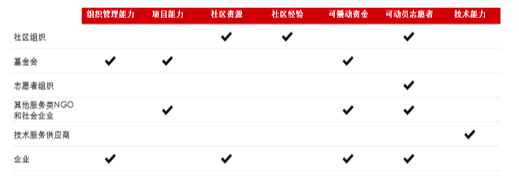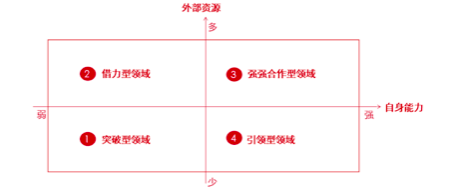New Frontier for Nonprofit Sector in China: Community
Since the Nineteenth National Congress, community governance has become the focus of social governance. Building a collaborative and shared community governance model is a trend now. The government proposed a development path for community-based organizations (CBOs), emphasizing ‘meeting the needs of the masses’, ‘focusing on support and encouragement’ and ‘building capability as groundwork’1. And these CBOs are expected to play important roles in innovative grass-roots community governance.
For instance, in early 2019, Wuhou District government of Chengdu city promulgated the “Supporting Measures for Social Enterprises (SEs)” 2, so as to promote SEs to become essential players in community building and governance and important means for residents to participate in community issues. The government also cooperated with NPI, an NGO experienced in community issues, to provide a series of policy support for SEs, including financial incentives, incubation services, rental subsidy, talent support and etc. In addition, the district has set up an incubation platform to better serve SEs.

Community Cleaning Activity Source: Internet
Insight 1: What are the new opportunities in the community for various types of organizations?
As suggested by the top-down policies, not only do grass-roots authorities have the need to vigorously develop and enhance community services, social organizations are encouraged to participate in community governance. As a result, there will be more chances for social organizations to explore community-related business or funding schemes. To seize the right opportunities, different types of organizations need to identify their own comparative advantages (see Table I).

Table I: Stakeholders’ comparative advantages in community building*
* The table is based on the overall development of certain types of organizations in China, while the actual situation of individual organizations may be different and should be analyzed on a case-by-case basis.
As for Community Based Organizations (CBOs), they have rich experience in community mobilization and services. Through better cooperation with grass-roots authorities and residential committees, CBOs will be able to leverage more community resources and to provide more services, such as community elderly care, community child care, community negotiation and etc., so as to become the driving force for community building.
As for charitable foundations, they are better skilled in organizational management and project management, as well as leveraging funding resources from the society. Therefore, on one hand, foundations can empower CBOs and then engage in community building through CBOs; on the other hand, foundations can utilize their organizational and funding advantages to provide community services independently.
As for other social organizations, technical service providers and corporate CSR, like charitable foundations, they can collaborate with CBOs to extend their projects to the community level and thus solving the “last mile” issue of social services delivery. Moreover, they can promote community building via supporting CBOs with funding and training, which will be dedicated to the professional development of CBOs in all aspects, such as bidding, fundraising, communications, project management and so on.
Insight 2: How may organizations resolve the ‘pain points’ they have in launching community business?
There could be quite a few constraints for organizations to extend their business to the community level, especially those lacking relevant experience. Potential issues include but not limit to identifying and understanding the relations between different grass-roots authorities (such as street, residential committee, women’s federation and other grass-roots governments and related agencies), identifying different types, characteristics, needs and access to the communities, and the monitoring and evaluation of community projects.
In the process of developing community projects, most organizations need to think about whether to address the pain points by working with others or on their own. VA provides a preliminary analytical matrix (see Table II) to help organizations make a strategic decision.

Table II: Strategic Choice Matrix
1. Entrepreneur
In the situation where an organization intends to develop a community project that is not yet within its own strength, and the external cooperative resource on the subject is limited, if the organization strongly believes in the great potential of the market, or the core team has a strong mission, then the organization can make a breakthrough exploration via small-scale pilot projects, and quickly enhance the requisite capabilities in the process. As an entrepreneur on the subject, the organization will advocate more stakeholders to invest in the topic.
For instance, there is a great demand for people with disabilities in rural communities to have job opportunities. At present, very few social organizations have touched on this subject. Most social organizations dedicated to serving people with disabilities mainly focus on the urban communities with initiatives about barrier-free facilities, fair employment, etc., and have little experience in rural communities. If an urban-focus organization plans to extend “employment” services to rural communities, while some experience in serving people with disabilities is transferrable, the organization still will face challenges of insufficient experience in rural communities(who to work with), limited external resources (very few governments tender invites for training projects for people with disabilities in rural area, and few job opportunities with corporates), and weak capacities (limited number of career training programs for people with disabilities to earn quality and up-to-date skills). Therefore, interested organizations can consider itself an entrepreneur of this subject and seek breakthrough via pilot projects, as well as enhancing their own capabilities along the pilot process, so as to advocate with the pilot outcome for more attention and investment in both the issue and the organization.
2. Turnkey Business
In the situation where an organization intends to develop a community project that is not yet within its own strength, but there are ample external resources available for cooperation, the organization can choose to cooperate with the external parties and launch business in the community with the help of external resources. Furthermore, the organization can utilize external resources to enhance its capabilities in communications, fund-raising, organizational management, monitoring and evaluation, so as to build a solid foundation for long-term contribution to community building.
For instance, some volunteer groups would like to carry out environmental monitoring and advocacy activities in the community, but they have little environmental knowledge and are not equipped with advocacy materials. Under such circumstances, the volunteer groups can work hand in hand with professional environmental organizations, which can provide professional tool-kits and brochures for the former to launch activities in the community.
3. Alpha Alliance
In the situation where an organization intends to develop a community project that is within its own strength, and there are various external resources and stakeholders available for cooperation, the organization can propose to co-build issue networks or platforms with key stakeholders, so as to produce network consensus and amplified output from the network.
For example, on the issue of waste sorting and disposal in communities, a plenty of strong stakeholders have emerged, including the government, providers of front-end, mid-end and back-end products and service, funders, researchers and other parties. All parties have their own comparative advantages (e.g. the governments’ strong appealing power, CBOs’ strong execution power, and funders’ financial resources). Therefore, stakeholders can work together to establish an alpha network on community waste sorting and disposal, resulting in a win-win solution.
4. Beacon
In the situation where an organization intends to develop a community project that is within its own strength, but with little external resource to leverage, the organization can work on its own to build an implementation network at community level, so as to strengthen its unique competitiveness in this subject and to better serve the needs of communities.
For example, there are both local family groups and a large number of migrant workers living in a traditional community of Guangzhou alongside the Pearl River. In order to cultivate a common sense of belonging for the community within both population groups, a local community organization, based on the community’s dragon boat culture, developed innovative Dragon Boat cultural activities, built an online service platform for community integration and motivated community participation in river monitoring. As there was limited external resources or partners to work with, the organization came up with the above innovative solutions on their own and has thus sharpened their specialization in community culture cultivation. As a result, the organization was awarded the “Guangzhou Social Innovation Award” for its projects, and has led the trend of local community governance.
To draw a conclusion,when facing the great amount of demands from communities, many parties may have a hard decision on ‘whether or not and how to enter the nonprofit market at community level’. VA encourages all parties to start from clarifying their own internal advantages and accessibility of external resources, so as to identify and adopt the right strategies for individual organization, which may then achieve the growth of the new business.
Reference:
1、民政部:《关于大力培育发展社区社会组织的意见》
2、武侯区:构建社区公益生态圈 推动社区发展治理创新
